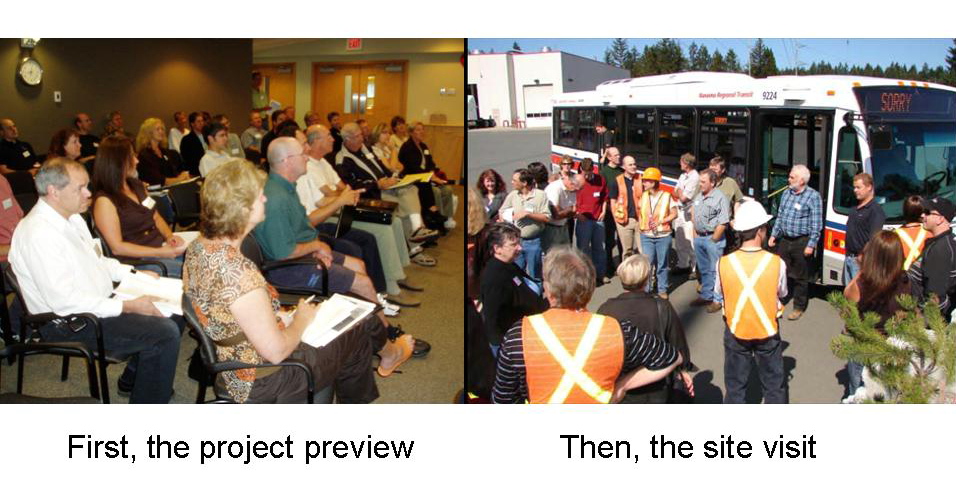Creating Our Future on Vancouver Island – Green Infrastructure Leadership Forum organized by CAVI will celebrate successes and showcase innovation
Local governments gather on December 3, 2007 to ask: What could our communities look like in 50 years?
Communities in the Georgia Basin are being transformed by settlement and economic growth. While the province has been experiencing a development boom, the need to mitigate pressures on land and water resources has provided a driver for a ‘green infrastructure’ movement that is water-centric and is founded on a natural systems approach.
Advancing a new way-of-thinking and acting
The Association of Vancouver Island Coastal Communities (AVICC), which represents local government on Vancouver Island and in coastal communities, is partnering with CAVI-Convening for Action on Vancouver Island to advance a new way-of-thinking and acting related to infrastructure policies and practices.
 “The first deliverable is the Green Infrastructure Leadership Forum on December 3, 2007 in Nanaimo,” reports Rod Sherrell, AVICC President and Chair of the Mount Waddington Regional District. To learn more about the basis for the AVICC-CAVI partnership, please click here.
“The first deliverable is the Green Infrastructure Leadership Forum on December 3, 2007 in Nanaimo,” reports Rod Sherrell, AVICC President and Chair of the Mount Waddington Regional District. To learn more about the basis for the AVICC-CAVI partnership, please click here.
According to John Finnie, CAVI Chair (and General Manager, Environmental Services, for the Regional District of Nanaimo), “The Leadership Forum is designed for elected representatives and senior managers in local government. The goal is to start a conversation that will lead to a region-wide dialogue in 2008 around achieving settlement in balance with ecology – AVICC and CAVI call this A Positive Settlement Strategy for Vancouver Island & Coastal Communities.”
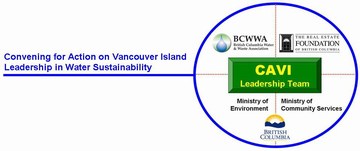
What could Vancouver Island look like in 50 years?
John Finnie explains that A Positive Settlement Strategy would take Vancouver Islanders to the next level of awareness because it shines a spotlight on the necessary link between accommodating settlement growth while protecting the ecological systems upon which community well-being depends.
- The operative words are vision, partnerships, communication, ecological integrity, human well-being, water sustainability, water-centric…and simply put…a desire to work together for Vancouver Island.
- CAVI and AVICC share a vision that water sustainability on Vancouver Island and in coastal communities will be achieved through implementation of green infrastructure policies, practices and standards.
To explore what application of A Positive Settlement Strategy might mean on-the-ground, the Leadership Forum will brainstorm this question: Through implementation of infrastructure policies and practices that reflect a Design with Nature guiding philosophy, what could Vancouver Island and coastal communities look like in 50 years?
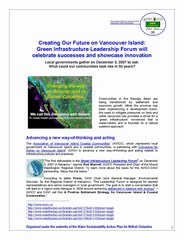 Downloadable Document:
Downloadable Document:
To download a copy of this web story as a report-style document, either click on the adjacent image or on click on the following link to Creating Our Future on Vancouver Island – Green Infrastructure Leadership Forum will celebrate successes and showcase innovation.
For Event Registration: For program and registration information, please click on this link to download Green Infrastructure Leadership Forum: Creating Our Future
Forum has two-part structure
The Leadership Forum is being held under the over-arching umbrella of the Water Sustainability Action Plan for British Columbia, and will be co-moderated by John Finnie and Kim Stephens (Program Coordinator for the Action Plan). The Leadership Forum is structured in two parts.
In the morning, there will be a ‘roundtable sharing session’ that builds on the recently completed Showcasing Green Infrastructure Innovation Series. According to Kim Stephens, “Celebration of on-the-ground successes is designed to both energize Forum participants and prepare them for the ‘brainstorming session’ that will follow in the afternoon.”
In the afternoon, Leadership Forum participants will divide into breakout groups that will be organized under parallel workshop streams to reflect the urban and rural perspectives. “One workshop stream will focus on how regional growth strategies can be aligned with A Positive Settlement Strategy,” explains Stephens, “The other workshop stream will consider how official community plans can be aligned with A Positive Settlement Strategy.”
Setting the Context
Leadership Forum participants are being provided with a `reading package` in advance of the event. The expectation of AVICC and CAVI is that participants will have done their pre-reading and will come prepared to have a conversation.
The team of John Finnie, Rod Sherrell and Tim Pringle (Executive Director, Real Estate Foundation of BC) will combine to establish expectations for the day. Their presentations will be brief so that the Forum can quickly transition into the interactive session. Each will focus on one key message that they want the audience to remember:
 John Finnie: “The CAVI role is to provide venues which create opportunities to start conversations that will ultimately lead to action. CAVI is facilitating the move from awareness (interest) to action(practice) in changing where and how land is developed, how water is used, and how water runs off the land.”
John Finnie: “The CAVI role is to provide venues which create opportunities to start conversations that will ultimately lead to action. CAVI is facilitating the move from awareness (interest) to action(practice) in changing where and how land is developed, how water is used, and how water runs off the land.”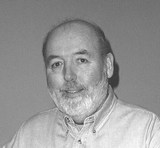 Rod Sherrell: “If we are to control our destiny, then we need to challenge Vancouver Islanders to visualize what they want this place to look like in 50 years and get on with creating our future. The conversations can evolve into a dialogue about Why, Where and How development should occur so that settlement is in balance with ecology.”
Rod Sherrell: “If we are to control our destiny, then we need to challenge Vancouver Islanders to visualize what they want this place to look like in 50 years and get on with creating our future. The conversations can evolve into a dialogue about Why, Where and How development should occur so that settlement is in balance with ecology.”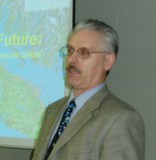 Tim Pringle: “Simply put, A Positive Settlement Strategy means benefits exceed liabilities. Settlement and ecology are equal values, and they must be as much in balance as possible for the wellbeing of human and natural systems. We are convening for action so that we can provide practitioners with the tools and experience to implement Design with Nature policies and practices.”
Tim Pringle: “Simply put, A Positive Settlement Strategy means benefits exceed liabilities. Settlement and ecology are equal values, and they must be as much in balance as possible for the wellbeing of human and natural systems. We are convening for action so that we can provide practitioners with the tools and experience to implement Design with Nature policies and practices.”
Infrastructure design on Vancouver Island is changing. Cumulative benefits are achievable, one property at a time, through changes in policies, programs practices and standards that determine how land is developed and water is used.
Showcasing Green Infrastructure Innovation
The goal in showcasing innovation and celebrating successes is to promote networking, build regional capacity, and move ‘from awareness to action’ – through sharing of green infrastructure approaches, tools, experiences and lessons learned as an outcome of designing with nature.
According to John Finnie, “Showcasing Green Infrastructure Innovation on Vancouver Island: The 2007 Series has resonated with local government because it provides them with a platform to tell their stories. No other forum meets this need.”
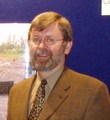 “There are a lot of good things happening in communities throughout Vancouver Island, but those stories had not been getting out,” adds Kim Stephens, “Through many one-on-one conversations, we found those stories; and then we pulled together a partnership of three regional districts and their member municipalities to host a series of one-day events.”
“There are a lot of good things happening in communities throughout Vancouver Island, but those stories had not been getting out,” adds Kim Stephens, “Through many one-on-one conversations, we found those stories; and then we pulled together a partnership of three regional districts and their member municipalities to host a series of one-day events.”
To energize Forum participants and prepare them for the afternoon session, the interactive morning session is organized in five segments. The emphasis is on the ‘telling of stories’ because people learn through story-telling.
Inland Kenworth Case Study in Nanaimo: Where Designing with Nature meets Green Value
To kick off the interactive session, and as an alternative to providing academic definitions of what Designing with Nature and Green Value mean, Kim Stephens will tell the story of the Inland Kenworth facility in Nanaimo. He notes that this case study provides an easy to absorb point-of-departure so that participants will have a mind-map for what follows.
Stephens reports that the site development for the Inland Kenworth truck and heavy 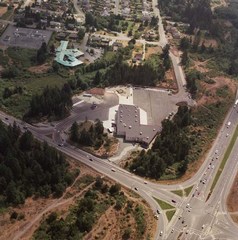 equipment facility in Nanaimo illustrates how “designing with nature” and “green value” converge to produce a superior outcome, while reducing the ‘hydrologic footprint’. The site is situated at the intersection of the intersection of the Nanaimo Parkway and Northfield Road, and is close to a residential area. According to City of Nanaimo staff, one of the early keys to success was the time that City staff, the owner’s representative and the design team spent walking the site.
equipment facility in Nanaimo illustrates how “designing with nature” and “green value” converge to produce a superior outcome, while reducing the ‘hydrologic footprint’. The site is situated at the intersection of the intersection of the Nanaimo Parkway and Northfield Road, and is close to a residential area. According to City of Nanaimo staff, one of the early keys to success was the time that City staff, the owner’s representative and the design team spent walking the site.
“From a City of Nanaimo staff perspective, the Inland Kenworth industrial development is a milestone project because it represents the turning of the tide in the way land is being developed in the City,” reports Kim Stephens, “Furthermore, the raised expectations have changed the nature of consulting in Nanaimo by stimulating green infrastructure innovation. In addition, the design philosophy is being replicated in other communities, notably Courtenay.”
 At the Nanaimo Showcasing Innovation event, Dean Mousseau (Manager, Development Engineering) provided this perspective of the changes currently taking place in Nanaimo: “Even in traditional, hard-piped urban areas where it would be easy to connect to storm sewers that discharge to the ocean, project proponents are telling us that they want to be innovative when redeveloping their properties. We are turning the tide because development and redevelopment projects are now incorporating features for rainwater runoff capture.”
At the Nanaimo Showcasing Innovation event, Dean Mousseau (Manager, Development Engineering) provided this perspective of the changes currently taking place in Nanaimo: “Even in traditional, hard-piped urban areas where it would be easy to connect to storm sewers that discharge to the ocean, project proponents are telling us that they want to be innovative when redeveloping their properties. We are turning the tide because development and redevelopment projects are now incorporating features for rainwater runoff capture.”
To learn more about the Inland Kenworth development and the Toyota and Mazda car dealership site developments in Courtenay, please click on the following link to download Case Study Profiles for Three Design with Nature Commercial Developments in Nanaimo and Courtenay.
Reporting Out: The Culture of Doing & Lessons Learned
The purpose in reporting out on the Showcasing Innovation Series is to celebrate…and build on…the on-the-ground successes that are enhancing the ways communities are being developed and water is being managed. Representatives of the seven participating local governments will speak from the floor in highlighting what they showcased in 2007 and commenting on what they learned from the process.
“Organizing the Showcasing Innovation Series was an energizing experience for me….because I saw how excited people became,” observes Kim Stephens, “When we reflected on what was taking place within these host local governments, it became clear to us that we were observing a ‘culture of doing’ that makes it possible for champions to emerge.”
“At the Leadership Forum, the plan is to set aside about 30 minutes so that these champions can tell their stories,” explains Kim Stephens, “Our hope is that this will inspire others to share their stories.”
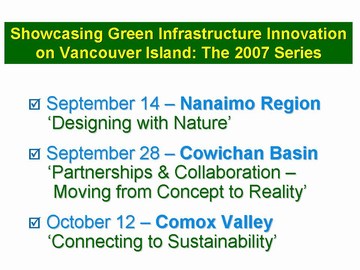
Each event was co-hosted by a regional district and one or more of its member municipalities. Each event comprised presentations in the morning and a tour of project sites in the afternoon. Each event was unique. The total registration was approximately 140, with attendees representing four regional districts and fifteen municipalities. Registration for each event was capped based on bus capacity.
According to Kim Stephens, “A Showcasing Innovation event is not a conference. Neither is it a workshop nor seminar in the conventional sense. Rather the purpose of the presentations is to whet the appetites of participants for the site tour that follows. The quality one-on-one conversations take place on the bus and when we go for a walkabout.”
The reporting out on the Showcasing Innovation Series will flow into a Roundtable Sharing segment.
Roundtable Sharing: What Else is on the Drawing Board?
Other local governments participating in the Leadership Forum will be invited to ‘tell their stories’ and talk about examples of green infrastructure innovation in their communities. This around-the-table sharing will be facilitated by Cori Barraclough of the CAVI Leadership Team.
 “Innovation can be at any scale. In fact, sometimes a project as small as a rain garden…or a traffic roundabout…or a streetscape enhancement….can be symbolic of a culture change in a municipality,” observes Cori Barraclough, “We want to hear those stories. We hope elected representatives and senior managers will tell us about what their municipality has already built or will be building, or perhaps what they would like to see built.”
“Innovation can be at any scale. In fact, sometimes a project as small as a rain garden…or a traffic roundabout…or a streetscape enhancement….can be symbolic of a culture change in a municipality,” observes Cori Barraclough, “We want to hear those stories. We hope elected representatives and senior managers will tell us about what their municipality has already built or will be building, or perhaps what they would like to see built.”
“As an outcome of the Leadership Forum, we would like to create a competitive spirit because competition is healthy,” adds Kim Stephens.
Beyond the Guidebook: Designing with Nature to Create Liveable Communities that Protect Stream Health
The 2003 UBCM Annual Conference was the venue for the formal rollout of the Water Balance Model for British Columbia. This web-based tool was developed as an extension of Stormwater Planning: A Guidebook for British Columbia, and enables users to visualize how to implement green infrastructure solutions that achieve rainwater runoff source controlat the site scale.
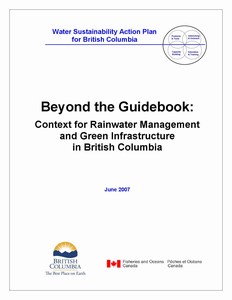 In 2007, the Leadership Forum will be the venue for a similar announcement by Chris Jensen (Ministry of Community Services) about Beyond the Guidebook: Context for Green Infrastructure and Rainwater Management in British Columbia and an enhanced Water Balance Model powered by QUALHYMO. Chris will elaborate on how the mandate of the Ministry of Community Services to promote sustainable, livable communities is linked to green infrastructure and RAINwater management.
In 2007, the Leadership Forum will be the venue for a similar announcement by Chris Jensen (Ministry of Community Services) about Beyond the Guidebook: Context for Green Infrastructure and Rainwater Management in British Columbia and an enhanced Water Balance Model powered by QUALHYMO. Chris will elaborate on how the mandate of the Ministry of Community Services to promote sustainable, livable communities is linked to green infrastructure and RAINwater management.
“Released in June, Beyond the Guidebook reflects lessons learned subsequent to publication of the Guidebook in 2002, and is supported by the enhanced Water Balance Model,” explains Chris Jensen, “Because the focus is on the relationship between the site and watershed, Beyond the Guidebook will help local governments achieve urban stream  health and environmental protection outcomes.”
health and environmental protection outcomes.”
Chris Jensen is Co-Chair of the inter-agency Vancouver Island Coordinating Team (VICT). Established as a sub-group of the Inter-Governmental Partnership that developed the Water Balance Model, the VICT mission is to facilitate a consistent, science-based approach to rainwater management on Vancouver Island. As an outcome of the Showcasing Innovation Series, VICT membership has expanded to include representatives from the City of Courtenay, City of Nanaimo, District of North Cowichan, and Cowichan Valley Regional District.
Creating Our Future in Ucluelet: from Vision to Implementation
To provide a transition between the ‘roundtable sharing’ and the ‘creating our future brainstorming’, Felice Mazzoni and Geoff Lyons of the District of Ucluelet will tell the story of what their municipality is doing to assert control over its destiny during an era of rapid change.
 The development pressures on the community are constant, which creates a challenge in maintaining community character and ‘sense of place’ for residents and visitors alike.
The development pressures on the community are constant, which creates a challenge in maintaining community character and ‘sense of place’ for residents and visitors alike.
According to Felice Mazzoni, Director of Planning, “Through careful planning and strong local political support, the District of Ucluelet has successfully implemented ‘smart growth’ sustainable planning tools such as density bonusing, alternative design standards, affordable housing policies, public access, comprehensive development zoning, and mandatory LEED construction.”
“The tools have been incorporated into day-to-day planning procedures as well as long-term planning for the future of the community,” continues Felice Mazzoni, “The planning principles can be implemented through a variety of means in terms of rezoning, development permits, or subdivision design and layout.”
“Ucluelet’s planning principles can be implemented and transferred to larger cities or other rural communities experiencing development pressures,” concludes Geoff Lyons, Chief Administrative Officer.
Alignment with ‘A Positive Settlement Strategy’
Leadership Forum participants will be invited to choose between two workshop themes, one regional and the other local, in advance of the event. A case study example will be presented for each theme.
According to Tim Pringle, “By listening to both a regional and local example before going into the breakout groups, we believe this will help participants wrap their minds around the question: How can your Regional Growth Strategy or Official Community Plan be aligned with A Positive Settlement Strategy?”
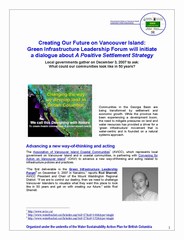 To read a parallel story that focuses on the rules of engagement for the ‘creating our future brainstorming’ session, either click on the adjacent image to download a report-style document; or click on the following link to access a web story titled Creating Our Future on Vancouver Island – Green Infrastructure Leadership Forum will initiate a dialogue about A Positive Settlement Strategy. This document is complete with a listing of other, related web resources that elaborate on what CAVI and AVICC wish to accomplish in the afternoon session.
To read a parallel story that focuses on the rules of engagement for the ‘creating our future brainstorming’ session, either click on the adjacent image to download a report-style document; or click on the following link to access a web story titled Creating Our Future on Vancouver Island – Green Infrastructure Leadership Forum will initiate a dialogue about A Positive Settlement Strategy. This document is complete with a listing of other, related web resources that elaborate on what CAVI and AVICC wish to accomplish in the afternoon session.
Who is CAVI?
The CAVI Partnership comprises the British Columbia Water & Waste Association, the Real Estate Foundation of British Columbia, the provincial Ministries of Environment and Community Services, and the Green Infrastructure Partnership.
CAVI is co-funded by the Province and the Real Estate Foundation of British Columbia. The Water Sustainability Committee of the BCWWA is the managing partner and is providing program delivery. For more information about the CAVI Partnership and what it wants to do, please click here.

Posted November 2007






